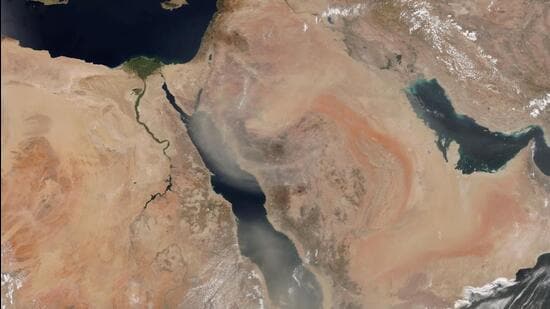Can dust storms in Middle East alleviate drought conditions in India?
The study -- Arabian Sea Aerosol-Indian Summer Monsoon Rainfall relationship and its modulation by El-Nino Southern Oscillation -- demonstrates how aerosolised dust particles
Mumbai: Dust storms originating from the Middle East and Northern Africa may be able to alleviate drought conditions over South Asia, including parts of India, suggests a new study by researchers at IIT-Bhubaneswar, published this month in the peer-reviewed journal Climate and Atmospheric Science, brought out by the Nature Group.

The study -- Arabian Sea Aerosol-Indian Summer Monsoon Rainfall relationship and its modulation by El-Nino Southern Oscillation -- demonstrates how aerosolised dust particles, which are transported above the Arabian Sea from the Middle East and surrounding areas during dust storms, can enhance rainfall over South Asia.
Researchers have also demonstrated that this phenomenon is likely to occur during severe drought episodes over the Indian region, which are observed alongside El-Nino climate events when warmer than usual waters in the equatorial region of the Pacific Ocean pull moisture-laden clouds away from the Indian subcontinent.
This is made possible due to the warming induced by aerosolised dust over the Arabian Sea. When strong winds spread the dust over the ocean, it creates a heat trap, in turn, providing a vital source of energy that speeds up monsoon circulation of winds and moisture towards the Indian landmass.
“Our research has shown that this phenomenon occurs in a rather short time scale, of one or two weeks at most,” said V Vinoj, assistant professor at the School of Earth Ocean and Climate Sciences at IIT-Bhubaneswar.
Vinoj added that this phenomenon is particularly pronounced during drought years associated with El-Nino, and that tracking this correlation is an important step in understanding changing rainfall patterns over India.
“In response to anthropogenic climate change, El-Nino-like conditions are likely to increase in the future, making the dust aerosol-induced monsoon rainfall enhancement/modulation significant,” the study notes.
“This might not completely solve the issue of drought in India during El Nino events, but it can certainly help to alleviate the meteorological aspects of drought to some degree in the future,” Vinoj explained. Also, going against the trend of the Indian summer monsoon which deposits rainfall largely in the Western Ghats and Central Indian plains, dust-induced rains do not show such regional selectivity.
“The rainfall over India during high aerosol loading conditions over the Arabian Sea is widespread across India, with the highest increase over the north, central and north-western India except the rain shadow region to the east of the western ghats,” the study notes.
MK Roxy, a climate scientist at the Indian Institute of Tropical Meteorology, who was not involved in the study, said these findings are significant. “Our own research shows a significant decreasing trend in the summer monsoon rainfall over the central Indian subcontinent over the last century, and that rapid warming in the Indian Ocean is playing an important role in weakening the monsoon circulation and the rainfall. This new study provides a much deeper understanding of this phenomenon and shows that other factors like dust might already be compensating for the drying monsoon effect to some extent, without which the impacts of global warming would have been larger. What needs to be done next is to quantify the contribution of such rainfall to the overall Indian summer monsoon, which will tell us more clearly the extent to which this phenomenon can mitigate drought,” he said.
In recent decades, India has faced droughts, large-scale rainfall deficits and changes in the spatial pattern of monsoon rainfall due to climate change. Scientists have also predicted a rise in the frequency and number of storms across Middle Eastern deserts in the coming years.
“This dust may get transported to the Arabian Sea under favourable conditions and trigger short heavy rain spells over the Indian region. In other words, nature compensates for the deficit created by human activities. It is well established that anthropogenic factors reduce rainfall and continue to do so over a long-timescale (decades). Still, the silver lining is that there is a short period of respite to this drying trend in the form of increased rainfall in short-timescales or about a week or two,” Vinoj said in a statement Friday.



